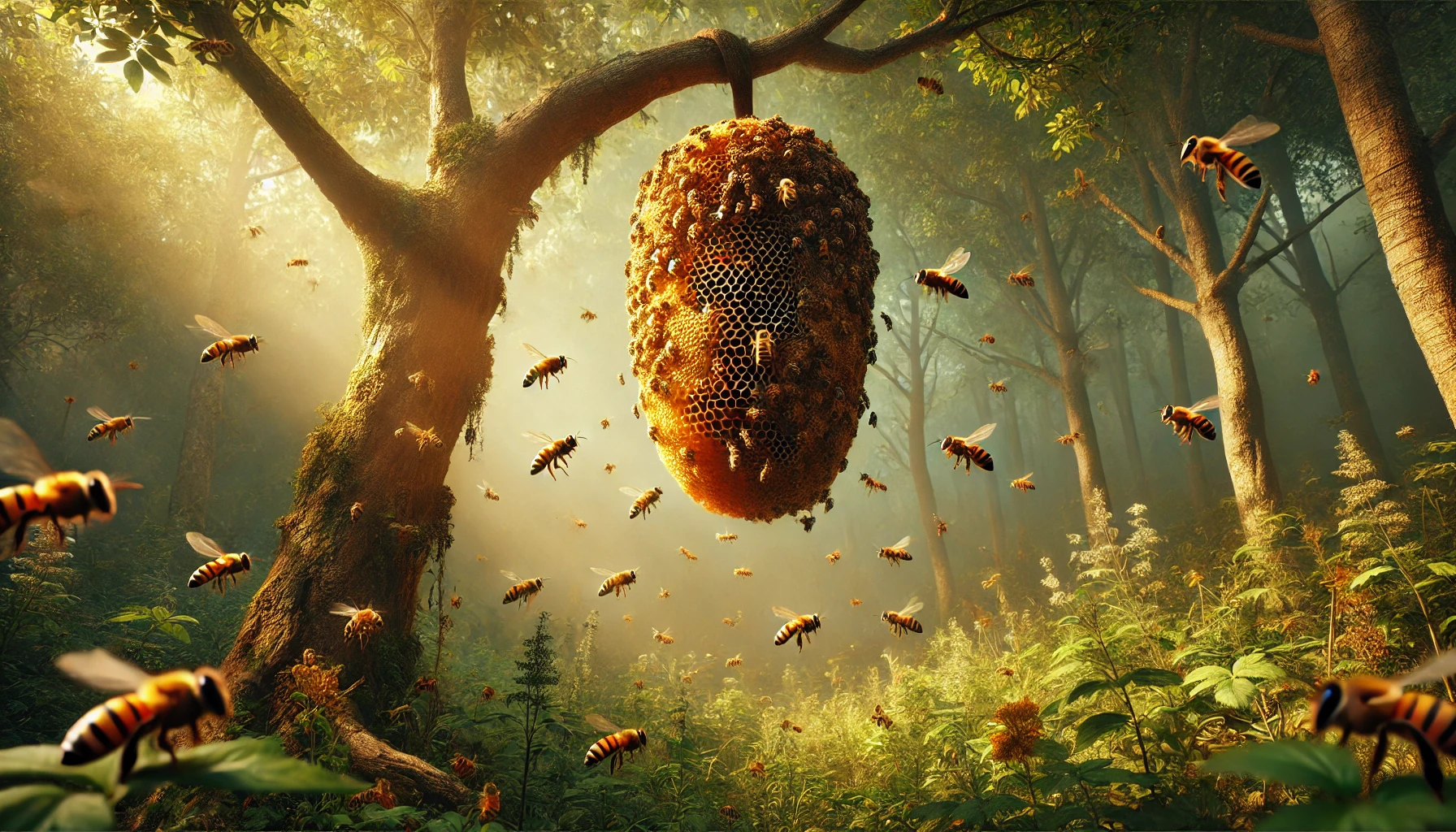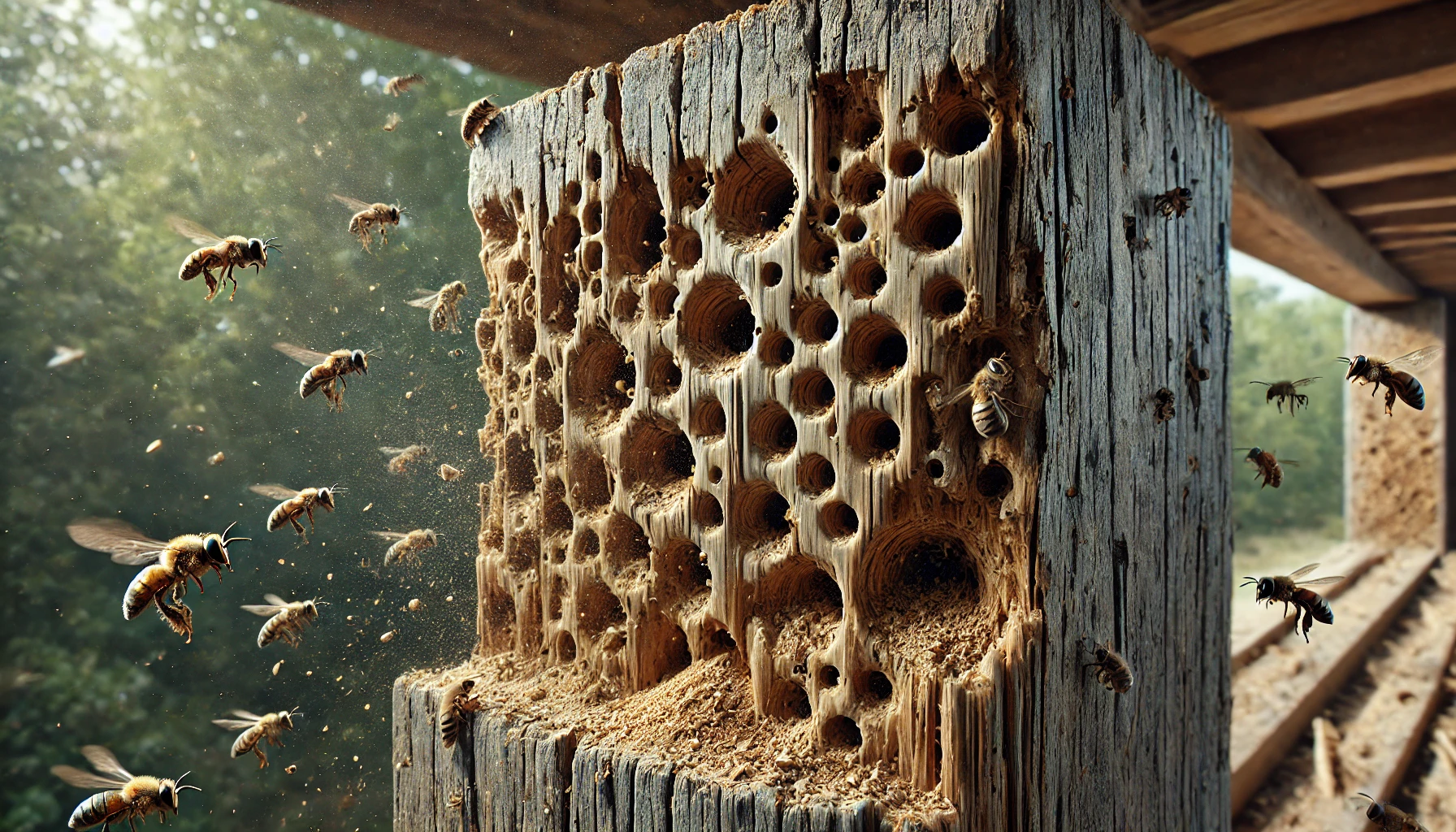Key Takeaways
- Increased bee activity near your home may indicate a hidden hive.
- Buzzing sounds in walls or ceilings can signal bees nesting inside.
- Honey stains or sticky residue on walls suggest a hidden hive leak.
- Unpleasant odors may come from decaying bees or abandoned hives.
 Bees play an essential role in our ecosystem, pollinating plants and producing honey. However, when they establish colonies in or around homes, they can become a nuisance and even a safety hazard. A bee infestation can pose risks such as property damage, aggressive stings, and attracting other pests. Identifying the signs early can help prevent and escalate further issues, which would help ensure proper removal.
Bees play an essential role in our ecosystem, pollinating plants and producing honey. However, when they establish colonies in or around homes, they can become a nuisance and even a safety hazard. A bee infestation can pose risks such as property damage, aggressive stings, and attracting other pests. Identifying the signs early can help prevent and escalate further issues, which would help ensure proper removal.
Here are some key indicators that help you to know that you may have a bee infestation in your home or yard. 1. Increased Bee Activity Around Your Property One of the first and most noticeable signs of a bee infestation is a sudden increase in bee activity around your home. If you notice more bees than usual hovering near your roof, windows, attic, or garden, it may indicate a hive nearby.
Bees tend to be most active in the morning and early afternoon, especially during the spring and summer when they search for nesting locations.Bees commonly build nests in sheltered areas such as eaves, wall cavities, chimneys, sheds, or tree hollows. If you see a steady flow of bees entering and exiting a small hole in a structure, it is a strong indication of an established hive. 2. Visible Bee Hives or Honeycombs Spotting an actual bee hive on your property clearly signifies an infestation. Honeybees create waxy honeycomb structures often found in wall voids, attics, or inside tree trunks. In some cases, hives may be exposed under eaves, on fences, or within sheds.
Unlike wasps, which build paper-like nests, honeybee hives are typically golden-brown with a hexagonal comb structure. If you see a beehive, do not attempt to remove it yourself, as this can provoke the colony and lead to aggressive behavior.


Not getting a solution?
Get your free pest control estimate today!The buzzing is most noticeable in quiet environments, such as at night when external noise levels are low. If you place your ear against a suspected area and hear a faint buzzing or rustling sound, it could indicate that bees have nested inside the structure. 4. Honey Stains or Sticky Residue on Walls When bees establish a hive inside a wall cavity or attic, honey leakage can become an issue. Over time, the honeycomb structure may become too full, causing honey to seep through the walls or ceiling. This can appear as dark, sticky stains on drywall, ceilings, or wooden beams.
These stains can attract other pests such as ants, cockroaches, and rodents, which are drawn to the sugar content of the honey. In some cases, the weight of the honeycomb can even cause drywall or ceiling panels to collapse. If you notice unexplained brown or yellow stains on your walls or ceilings, investigate the area for possible bee activity. 5. Unpleasant Odors from Decaying Bees or Wax Over time, bee colonies naturally experience deaths within the hive. In cases where a hive is abandoned or a section of the colony dies off, the decaying bees and honey can produce a strong, unpleasant odor. This scent is often described as a mix of rotting sweetness and mildew.
Additionally, if a hive is left untreated inside a structure, the wax and honey may ferment, leading to an even stronger, sour odor. If you detect a persistent, foul smell near your walls, attic, or vents, it could be a sign of a neglected or abandoned hive. 6. Small Holes or Wood Damage from Carpenter Bees Not all bee infestations involve honey-producing species. Carpenter bees, a different type of bee, create problems by burrowing into wooden structures. Unlike honeybees, carpenter bees do not form large colonies but instead drill small, round holes into wood to lay eggs. Common areas where carpenter bees may nest include:
- Wooden decks and railings
- Fences
- Roof eaves
- Window frames
- Outdoor furniture
 7. Aggressive Bee Behavior and Frequent Stings
Most bee species are not naturally aggressive unless they feel threatened. However, if you or your pets experience frequent bee stings or aggressive bee behavior near certain areas of your home, it could indicate a nest nearby.
Aggressive behavior may include:
7. Aggressive Bee Behavior and Frequent Stings
Most bee species are not naturally aggressive unless they feel threatened. However, if you or your pets experience frequent bee stings or aggressive bee behavior near certain areas of your home, it could indicate a nest nearby.
Aggressive behavior may include:
- Bees buzzing loudly and flying at you when you approach a certain area.
- A sudden increase in multiple bee stings in the same location.
- Bees following you even after you move away.
What to Do If You Suspect a Bee Infestation
- If you able to recognize any of these listed signs of a bee infestation, it is now a proper time to take appropriate action to prevent further issues.
-
Do Not Disturb the Bees: Avoid spraying insecticide or attempting DIY removal, as this can cause the bees to become aggressive and increase the risk of stings.
-
Monitor the Area: Observe bee activity to locate the hive’s entry point and determine the size of the infestation before taking action.
-
Call a Professional: Contact a licensed beekeeper for humane removal or a pest control expert if removal is necessary to ensure safety.
-
Seal Entry Points: After the hive is removed, seal off any cracks, holes, or gaps in your home to prevent future infestations.
-
Keep Your Property Maintained: Trim tree branches, inspect outdoor wooden structures, and keep food sources covered to reduce the risk of attracting bees.
 Early detection and professional removal are the best ways to handle a bee infestation safely. By recognizing the early signs and acting in a quick manner, you can protect your home and ensure a bee-free living environment while promoting responsible bee conservation.
Early detection and professional removal are the best ways to handle a bee infestation safely. By recognizing the early signs and acting in a quick manner, you can protect your home and ensure a bee-free living environment while promoting responsible bee conservation.
If you feel things have gone out of control, it is advised to contact pest control professionals. Our team can provide a customized approach to protect your home effectively.
Visit our Species, Control, and DIY Guide sections for additional resources on bee and ways to tackle a bee infestation.





